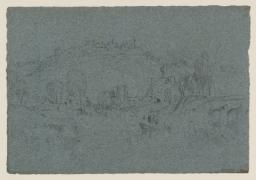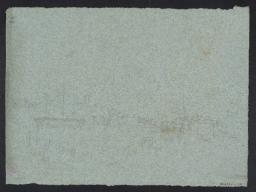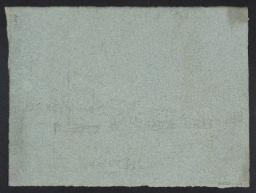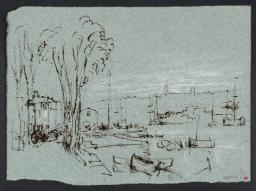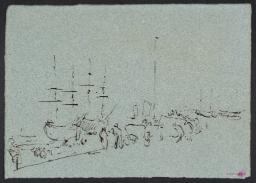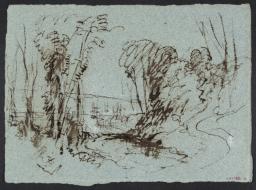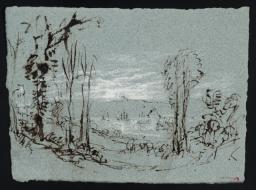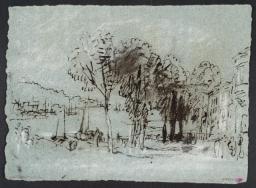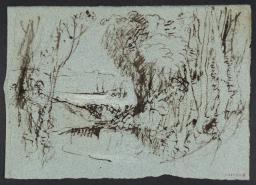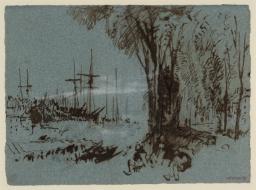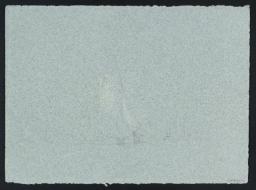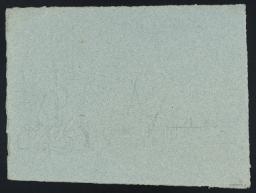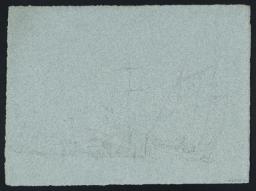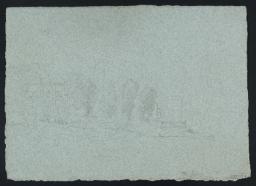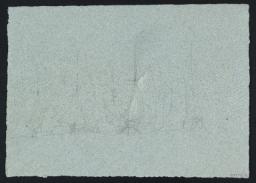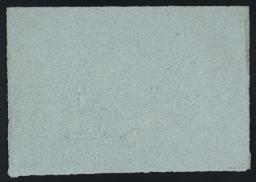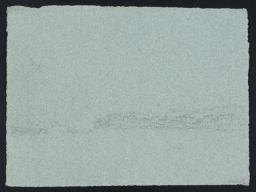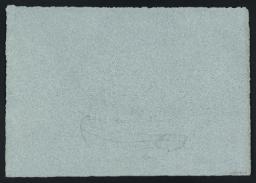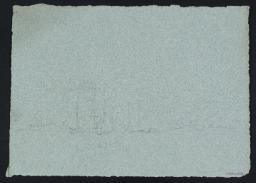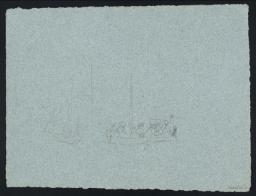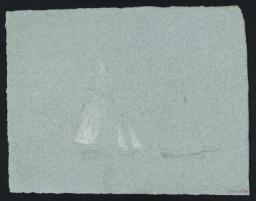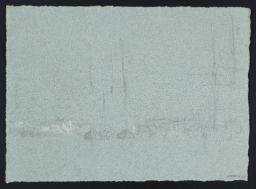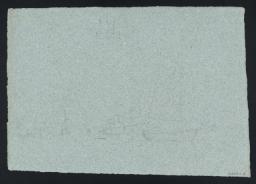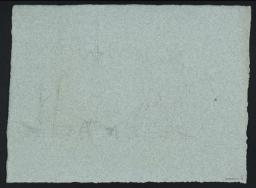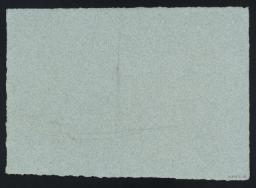Turner Bequest CCXXIV 26, 88, 114, 152, CCXXVII a 16, 51–57, CCXXVIII 1–44, CCLX 5, 29–32, 35, 36, 61, 62, 129
References
The blue paper sketches here can be divided into topographical and generic subjects. As the boundaries between the categories suggested below are somewhat fluid and the identifications of the slighter drawings rather speculative, this subsection includes all the blue paper drawings associated with the Isle of Wight in 1827, whether in ink or pencil (and with or without touches of white), other than those showing the house and grounds at East Cowes Castle, where Turner was staying with his friend and patron John Nash. The latter studies will be found in a parallel subsection, where the Introduction addresses Turner’s use of blue paper in the wider context of this phase of his career.1
These drawings serve to complement the sketchbooks and oil studies discussed in the overall Introduction to this tour, as Turner worked towards two paintings commissioned by Nash, the dynamic racing subject East Cowes Castle, the Seat of J. Nash, Esq.; the Regatta Beating to Windward (Indianapolis Museum of Art)2 and the serene harbour view of East Cowes Castle, the Seat of J. Nash, Esq.; the Regatta Starting for their Moorings (Victoria and Albert Museum, London)3 both exhibited at the Royal Academy in 1828. In addition to the Turner Bequest CCXXVIII works making up the bulk of these Cowes studies, Martin Butlin, Andrew Wilton and John Gage recognised a number categorised by Finberg ‘among the French Rivers material’4 (Turner Bequest CCLX)5 as noted in individual entries here and in the East Cowes Castle subsection; Ian Warrell has since added numerous others.6
East Cowes Castle is clearly seen in the distance in Tate D24868 (Turner Bequest CCLX 32), and perhaps in D20868 and D20895 (CCXXVIII 8, 35). The tower on the skyline in D20384, D20412 and D20857 (Turner Bequest CCXXIV 88, 114, CCXXVII a 54) may be that of the house, or possibly of St Mary’s Church (also designed by Nash),7 on the opposite bank of the River Medina above Cowes. The town of Cowes is seen to the west across the river in D20819, D20854, D20856, D20857–D20860, D24841, D24865 and D24866 (CCXXVII a 16, 51, 53, 54, 55, 56, 57, CCLX 5, 29, 30), while Cowes Castle is seen on the shoreline at its mouth in D20865, D20899 and D20904 (CCXXVIII 5, 39, 44).
The only identified subject outside the immediate Cowes-East Cowes area is Carisbrooke Castle, about five miles inland to the south (Tate D20316; Turner Bequest CCXXIV 26); the status and dating of that isolated study is a little uncertain, as discussed in its individual entry. Otherwise, there are various generic harbour and coast scenes with shipping moored or under way, without enough detail to be sure of their settings, in D20855, D20863, D20870–D20872, D20874–D20876, D20879, D20880, D20882–D20884, D20892, D20893, D20898, D24867, D24871, D24872, D24897 and D24965 (CCXXVII a 52, CCXXVIII 3, 10, 11, 12, 14, 15, 16, 19, 20, 22, 23, 24, 32, 33, 38, CCLX 31, 35, 36, 61, 129); see also D40308 and D40309 (the versos of CCXXVIII 36 and 38).
Tate D20881 (Turner Bequest CCXXVIII 21) with figures in the foreground and shipping apparently under sail at some speed beyond, may represent spectators at the Cowes Regatta events, which Turner recorded in detail elsewhere, as noted in the overall Introduction to this tour. The sheets here include many with boats at sea, some apparently being yachts racing: D20861, D20862, D20864, D20866, D20873, D20877, D20885, D20887, D20891, D20897, D20900, D20901, D20902, D24898 (CCXXVIII 1, 2, 4, 6, 13, 17, 25, 27, 31, 37, 40, 41, 42, CCLX 62), and D40307 (the verso of CCXXVIII 23). The buoy in D20867 (CCXXVIII 7) may relate the one in the Beating to Windward painting, while in D20896 (CCXXVIII 36) there is wreckage ominously strewn on a beach. Despite John Ruskin’s dismissive opinion (see the technical notes below), Graham Reynolds has characterised the Turner Bequest CCXXVIII grouping as a ‘search for the aspect of ships under sail scribbled down with instantaneous haste’, showing ‘the necessity [Turner] felt under to be exactly aware of the constantly changing aspects of objects in motion’.8
As well as the studies of shipping in motion in various situations, there are also a number which record the hulls and rigging of individual vessels in isolation and in more considered detail: Tate D20455, D20869, D20878, D20886, D20888–D20890, D20894, D20903 (Turner Bequest CCXXIV 152, CCXXVIII 9, 18, 26, 28, 29, 30, 34, 43); compare a study in the contemporary Windsor and Cowes, Isle of Wight sketchbook (Tate D20625; Turner Bequest CCXXVI 18a).
Unusually for Turner, who rarely gave his works away, there are a number of associated drawings in ink and in pencil in other collections, apparently made at or around this time as gifts. Shipping (Yale Center for British Art, New Haven),9 is a subject in ink and gouache on a sheet of blue paper similar in size to those catalogued here, and initialled ‘JMWT’. Worked up to a higher degree of finish, with sails picked out in white and pale brown, it shows three boats under sail in choppy seas with a ship silhouetted beyond, and is comparable with the scene in Tate D24898 (Turner Bequest CCLX 62).
Two initialled works in of similar media and sizes (currently untraced) were sold at Sotheby’s, London, on 25 March 1920,10 when they were reproduced. Lot 182 was View of a Sea Port, with a row of waterfront buildings and trees in the distance and numerous figures arranged down prominent steps in the foreground at the bottom right. Ian Warrell11 has compared it in particular to the setting of Sketch for ‘East Cowes Castle, the Regatta Starting for Their Moorings’ No.3, of 1827 (Tate N01997),12 one of the oil studies for East Cowes Castle, the Seat of J. Nash, Esq.; the Regatta Starting for their Moorings, exhibited at the Royal Academy in 1828 (Victoria and Albert Museum, London).13 There are clear similarities, although the foreground of the oil sketch, with spectators on the sloping shore below the barbican of Cowes Castle, has been replaced in the drawing by the simpler albeit monumental steps. Compare the steep flight rising to the left below a high harbour wall or pier in Tate D20874 and D24871 (CCXXVIII 14, CCLX 35).
Lot 183 in the 1920 sale, Fishing Boats at Sea: Boarding a Steamer, shows rowing and sailing boats off shore, with a large steamer silhouetted in the background; as Warrell has observed, this appears to be the same vessel as in Tate D24871 and D24872 (Turner Bequest CCLX 35, 36). An ink and gouache Study of Boats in the Whitworth Art Gallery, Manchester,14 is initialled in the same way and is comparable with D24867 (CCLX 31) in particular; it shows rowing boats off the shore, a large, moored boat with yachts sailing by, and another steamer in the distance.
Two small drawings of shipping in emphatic pencil on white sheets (private collection) are also initialled. Cowes Harbour15 shows a buoy and passengers in rowing boats in the foreground, with moored shipping beyond including a small warship which seems to be the one shown in Tate D20455 (Turner Bequest CCXXIV 152). Man of War and Cutter16 shows the latter passing a three-master moored in the background in the open sea, and is similar in spirit to the Yale ink drawing; compare also the 1820s pencil studies of shipping, Tate D17762–D17766 (Turner Bequest CCIII E–I).17 These two private collection drawings were apparently presented to a woman who was also staying at East Cowes Castle;18 he made a similar presentation drawing of a local subject (private collection) to a female relative of his host, Lord Egremont, when staying at Petworth House at about this time19 (see the overall Introduction to this tour).
Lastly, there are two slightly larger initialled Isle of Wight-related drawings in a similar style in the National Gallery of Ireland, Dublin, and the National Galleries of Scotland, Edinburgh,20 both bequeathed by Henry Vaughan (1809–1899), who had acquired them from T.G. Lupton (1791–1873), one of Turner’s engravers.21 The Dublin Shipping22 shows a small merchantman and a two-masted lugger with other shipping beyond, in a breeze off a pier to the right. Edinburgh’s Man of War23 depicts a calmer harbour scene with a moored warship, and figures and boats around steps on the right with a buoy in the left foreground.
Texts cited there which mention the Isle of Wight blue paper subjects in general include Wilton 1979, pp.165, 407, Hartley 1984, p.50, Warrell 1989, p.64, Nugent and Croal 1997, p.74, and Warrell 1999, pp.30, 253 note 84, 254 note 87.
Martin Butlin and Evelyn Joll, The Paintings of J.M.W. Turner, revised ed., New Haven and London 1984, p.150 no.242, pl.246 (colour).
Finberg 1909, II, pp.806–13, CCLX 1–136, ‘Pencil and ink on blue paper: mostly connected with “French Rivers” series’, c.1830.
See ‘About the Building’, Welcome to St Mary the Virgin Church, Cowes, accessed 15 December 2014, http://www.stmaryschurchcowes.org.uk/about%20the%20building.html .
See ibid.; see also see also Hartley 1984, p.50, and Nugent and Croal 1997, p.74, and Warrell 1999, p.253 note 84.
Martin Butlin and Evelyn Joll, The Paintings of J.M.W. Turner, revised ed., New Haven and London 1984, p.161 no.265, pl.270 (colour).
See Martin Butlin, Mollie Luther and Ian Warrell, Turner at Petworth: Painter and Patron, London 1989, p.128, fig.124; see also Warrell 1991, p.65, and Warrell 1999, p.253 note 84.
Anne Hodge and Naimh Mac Nally, The Works of J.M.W. Turner at the National Gallery of Ireland, Dublin 2012, p.78.
Technical notes
How to cite
Matthew Imms, ‘Cowes, the River Medina and Shipping 1827’, subset, November 2015, in David Blayney Brown (ed.), J.M.W. Turner: Sketchbooks, Drawings and Watercolours, Tate Research Publication, November 2016, https://www

